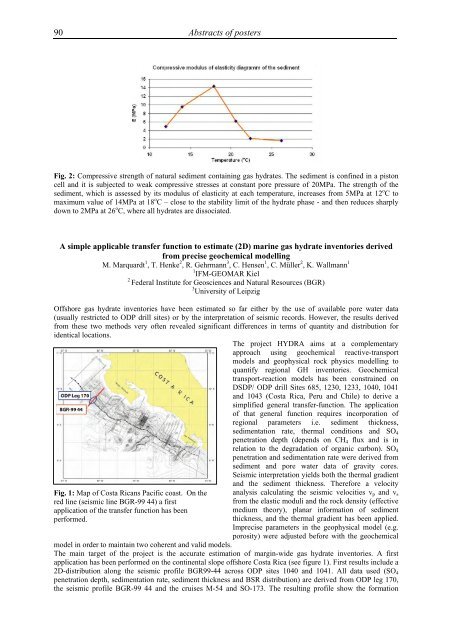Ninth international conference on - Marum
Ninth international conference on - Marum
Ninth international conference on - Marum
You also want an ePaper? Increase the reach of your titles
YUMPU automatically turns print PDFs into web optimized ePapers that Google loves.
90<br />
Abstracts of posters<br />
Fig. 2: Compressive strength of natural sediment c<strong>on</strong>taining gas hydrates. The sediment is c<strong>on</strong>fined in a pist<strong>on</strong><br />
cell and it is subjected to weak compressive stresses at c<strong>on</strong>stant pore pressure of 20MPa. The strength of the<br />
sediment, which is assessed by its modulus of elasticity at each temperature, increases from 5MPa at 12 o C to<br />
maximum value of 14MPa at 18 o C – close to the stability limit of the hydrate phase - and then reduces sharply<br />
down to 2MPa at 26 o C, where all hydrates are dissociated.<br />
A simple applicable transfer functi<strong>on</strong> to estimate (2D) marine gas hydrate inventories derived<br />
from precise geochemical modelling<br />
M. Marquardt 1 , T. Henke 2 , R. Gehrmann 3 , C. Hensen 1 , C. Müller 2 , K. Wallmann 1<br />
1 IFM-GEOMAR Kiel<br />
2 Federal Institute for Geosciences and Natural Resources (BGR)<br />
3 University of Leipzig<br />
Offshore gas hydrate inventories have been estimated so far either by the use of available pore water data<br />
(usually restricted to ODP drill sites) or by the interpretati<strong>on</strong> of seismic records. However, the results derived<br />
from these two methods very often revealed significant differences in terms of quantity and distributi<strong>on</strong> for<br />
identical locati<strong>on</strong>s.<br />
The project HYDRA aims at a complementary<br />
approach using geochemical reactive-transport<br />
models and geophysical rock physics modelling to<br />
quantify regi<strong>on</strong>al GH inventories. Geochemical<br />
transport-reacti<strong>on</strong> models has been c<strong>on</strong>strained <strong>on</strong><br />
DSDP/ ODP drill Sites 685, 1230, 1233, 1040, 1041<br />
and 1043 (Costa Rica, Peru and Chile) to derive a<br />
simplified general transfer-functi<strong>on</strong>. The applicati<strong>on</strong><br />
of that general functi<strong>on</strong> requires incorporati<strong>on</strong> of<br />
regi<strong>on</strong>al parameters i.e. sediment thickness,<br />
sedimentati<strong>on</strong> rate, thermal c<strong>on</strong>diti<strong>on</strong>s and SO4<br />
penetrati<strong>on</strong> depth (depends <strong>on</strong> CH4 flux and is in<br />
relati<strong>on</strong> to the degradati<strong>on</strong> of organic carb<strong>on</strong>). SO4<br />
penetrati<strong>on</strong> and sedimentati<strong>on</strong> rate were derived from<br />
sediment and pore water data of gravity cores.<br />
Seismic interpretati<strong>on</strong> yields both the thermal gradient<br />
Fig. 1: Map of Costa Ricans Pacific coast. On the<br />
red line (seismic line BGR-99 44) a first<br />
applicati<strong>on</strong> of the transfer functi<strong>on</strong> has been<br />
performed.<br />
and the sediment thickness. Therefore a velocity<br />
analysis calculating the seismic velocities vp and vs<br />
from the elastic moduli and the rock density (effective<br />
medium theory), planar informati<strong>on</strong> of sediment<br />
thickness, and the thermal gradient has been applied.<br />
Imprecise parameters in the geophysical model (e.g.<br />
porosity) were adjusted before with the geochemical<br />
model in order to maintain two coherent and valid models.<br />
The main target of the project is the accurate estimati<strong>on</strong> of margin-wide gas hydrate inventories. A first<br />
applicati<strong>on</strong> has been performed <strong>on</strong> the c<strong>on</strong>tinental slope offshore Costa Rica (see figure 1). First results include a<br />
2D-distributi<strong>on</strong> al<strong>on</strong>g the seismic profile BGR99-44 across ODP sites 1040 and 1041. All data used (SO4<br />
penetrati<strong>on</strong> depth, sedimentati<strong>on</strong> rate, sediment thickness and BSR distributi<strong>on</strong>) are derived from ODP leg 170,<br />
the seismic profile BGR-99 44 and the cruises M-54 and SO-173. The resulting profile show the formati<strong>on</strong>














